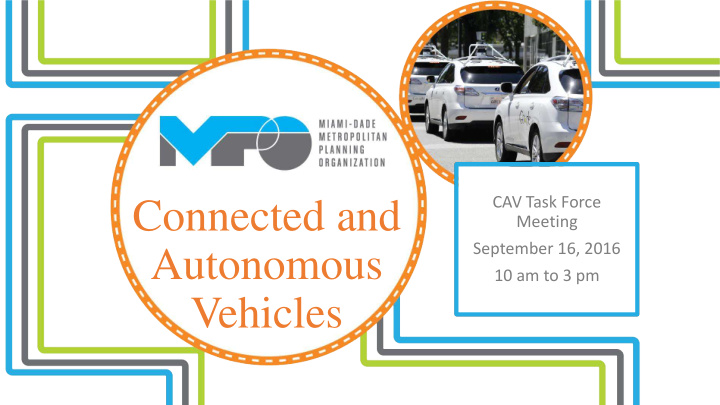



CAV Task Force Connected and Meeting September 16, 2016 Autonomous 10 am to 3 pm Vehicles
CAV Task Force Meeting
Introductions
Morning Session • Introductions • Opening Remarks • Mission Statement and Role • CAV 101: An Orientation • Overview: Miami-Dade County “Ollie” Pilot Project with IBM/Local Motors
Mission Statement and Role MISSION • Enhance interagency dialogue and collaboration • Facilitate CAV project development and deployment in Miami-Dade County ROLE • Build community awareness of CAV • Support pilot project implementation • Identify other potential CAV projects
CAV 101: An Orientation
The driver is in complete and sole control of the primary vehicle controls – brake, steering, throttle, and motive power – at all times.
Automation at this level involves one or more specific control functions. Examples include electronic stability control or pre-charged brakes, where the vehicle automatically assists with braking to enable the driver to regain control of the vehicle or stop faster than possible by acting alone.
This level involves automation of at least two primary control functions designed to work in unison to relieve the driver of control of those functions. An example of combined functions enabling a Level 2 system is adaptive cruise control in combination with lane centering.
Vehicles at this level of automation enable the driver to cede full control of all safety- critical functions under certain traffic or environmental conditions and in those conditions to rely heavily on the vehicle to monitor for changes in those conditions requiring transition back to driver control. The driver is expected to be available for occasional control, but with sufficiently comfortable transition time. The Google car is an example of limited self-driving automation.
The vehicle is designed to perform all safety-critical driving functions and monitor roadway conditions for an entire trip. Such a design anticipates that the driver will provide destination or navigation input, but is not expected to be available for control at any time during the trip. This includes both occupied and unoccupied vehicles.
AV M Market Dev Devel elopmen ent STAIRS ESCALATOR ELEVATOR Add automated features and Announce autonomy by a certain Currently designing applications one at a time. date while keeping and manufacturing fully (Most traditional OEMs) non-autonomous vehicles autonomous vehicles available for purchase (no staged implementation)
> Key A AV Co Considerati tions All fully autonomous vehicles Auto manufactures have said must independently: they want: • function in all weather conditions • No laws • recognize road lanes • Clear lane striping • recognize road signage • Clear signage • recognize other vehicles, obstacles, people, and bicycle RESPONSIBILITY OF VEHICLE MANUFATURERS POTENTIAL RESPONSIBILITY OF AGENCIES
Applications Intelligent Traffic Signal Speed Wrong Way Multi-modal Pedestrian/ Harmonization Driving Traffic Signal Priority Integration Bike Detection System
BU BUY SE SELL LL TRASH Data Co a Considerations KEEP EP
Privacy • Will I be tracked? Law enforcement applications? •
Q&A
The IBM “Ollie” Pilot Project
LUNCH • Video of industry initiatives • Further discussion
Afternoon Session • More about the technology • Deployment considerations • Briefings from technology leaders • Other potential CAV projects in Miami-Dade County • Emerging Priorities • Summary and Closing Remarks
More About the Technology
Deployment Considerations • Privacy • Safety • Liability
Technology Briefings • Technology Briefings: Remarks from Industry Leaders
Emerging Priorities • Safety and mobility • Shared mobility on-demand • Addressing mobility congestion • Using existing infrastructure • Scalability • Differently abled (disabled, seniors, etc…) • Somewhat improving technology • Preservation of mobility
Other Potential CAV Projects
Summary & Closing Remarks
Connected and Thank you Autonomous Vehicles
Recommend
More recommend